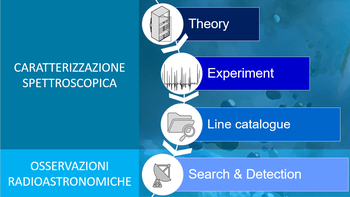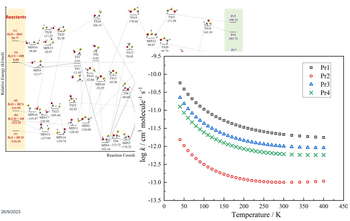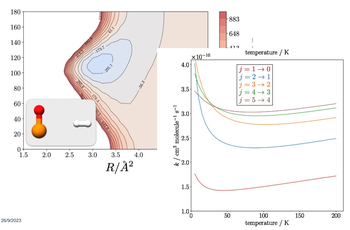Astrochemistry

Spectropscopy form the laboratory to the interstellar medium
The discovery of molecules in space is usually based on astronomical observation of the corresponding rotational transitions. In order to recognize these signals in the interstellar medium, the transitions have to be investigated in the laboratory. However, one often has to deal with molecules that on Earth are unstable and/or highly reactive, as the conditions of the interstellar medium allow different processes than those occurring on Earth, giving rise to exotic species. The strategy adopted by our laboratory to study these exotic species is based on the interplay between experiment and theory. Quantum-chemical calculations are used to predict the spectroscopic information needed to guide the recording, the analysis, and the assignment of spectra. Measurements of the rotational spectra are then performed in the centimeter/millimeter/sub-millimeter range of frequency, taking advantage of the in situ production for exotic molecules.
Spectral analysis of laboratory measurements leads to accurate spectroscopic parameters, which are then used for the creation of accurate transition lists to use in radioastronomical surveys.
For further details, the reader is referred to the following links on rotational and computational spectroscopy, but also to the key publications just after.

Reaction mechanisms for the formation of interstellar molecules
This research area includes the development and application of integrated computational strategies for the purpose of obtaining meaningful thermochemical and kinetic data inherent in the formation processes of complex organic interstellar species.
Collaborations in this area of research are established with the group of Professor V. Barone from Scuola Normale Superiore and the group of Prof C. Cavallotti from Politecnico di Milano.
Key publications are listed below.

Collisional Coefficients
In astrochemistry, molecular energy levels are rarely in local thermodynamic equilibrium (LTE) because the density in the interstellar medium is so low that collisions compete with radiative processes. Therefore, under non-LTE conditions the molecular abundance cannot be derived simply based on astronomically observed spectroscopic transitions but it is necessary to know the collisional coefficients for major perturbative species, e.g., molecular hydrogen or helium. Our group works on the derivation of such collisional coefficients and studies their effects on molecular abundances.
Some key publications are given in the links below.